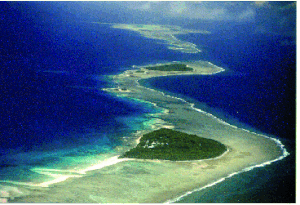Micronesia


Micronesia is a subregion of Oceania, comprising thousands of small islands in the western Pacific Ocean. It is distinct from Melanesia to the south, and Polynesia to the east. The Philippines and Indonesia lie to the west.
The name Micronesia derives from the Greek mikros (μικρός), meaning small, and nesos (νῆσος), meaning island. The term was first proposed to distinguish the region in 1831 by Jules Dumont d'Urville.
History
The only empire known to have originated in Micronesia was based in Yap. Much of the area was to come under European domination quite early. Guam, the Northern Marianas, and the Caroline Islands (what would later become the FSM and Palau) were colonized early by the Spanish. These island territories were part of the Spanish East Indies and governed from the Spanish Philippines since the early 17th century until 1898. Full European expansion did not come, however, until the early 20th century, when the area would be divided between:
- the United States, which took control of Guam following the Spanish-American War of 1898, and colonized Wake Island;
- Germany, which took Nauru and bought the Marshall, Caroline, and Northern Mariana Islands from Spain; and
- the British Empire, which took the Gilbert Islands (Kiribati).
During the First World War, Germany's Pacific island territories were taken from it and became League of Nations Mandates in 1923. Nauru became an Australian mandate, while Germany's other territories in Micronesia were given as a mandate to Japan and were named the South Pacific Mandate. This remained the situation until Japan's defeat in the Second World War, when its mandate became a United Nations Trusteeship ruled by the United States, the Trust Territory of the Pacific Islands.
Today, most of Micronesia consists of independent states, with the exceptions of Guam and Wake Island, which are U.S. territories, and the Northern Mariana Islands, which form a U.S. Commonwealth.
People
The people today form many ethnicities, but are all descended from and belong to the Micronesian culture. The Micronesian culture was one of the first native cultures of the region to develop. It developed from a mixture of Melanesians, Filipinos and Polynesians. Because of this mixture of descent, many of the ethnicities of Micronesia feel farther from some groups in Melanesia, Polynesia or the Philippines. A good example of this are the Yapese who are related to Austronesian tribes in the Northern Philippines.
Languages
The native languages of the various Micronesian indigenous peoples are classified under the Austronesian language family. Almost all of these languages belong to the Oceanic subgroup of this family; however, two exceptions are noted in Western Micronesia, which belong to the Western Malayo-Polynesian subgroup:
- Chamorro in the Mariana Islands
- Palauan in Palau.
This latter subgroup also includes most languages spoken today in the Philippines, Malaysia, and Indonesia (Kirch, 2000: pp. 166-167).
On the eastern edge of the Federated States of Micronesia, the languages Nukuoro and Kapingamarangi represent an extreme westward extension of Polynesian.
Associated Islands
The following islands and groups of islands are considered part of Micronesia:
- Banaba, an outlier of
 Kiribati
Kiribati - Gilbert Islands, which forms part of
 Kiribati
Kiribati - Mariana Islands, politically divided between
 Guam and the
Guam and the  Northern Mariana Islands
Northern Mariana Islands  Marshall Islands
Marshall Islands- Caroline Islands, politically divided between
 Palau and the
Palau and the  Federated States of Micronesia
Federated States of Micronesia  Nauru
Nauru Wake Island
Wake Island
Regional organizations
The region is home to the Micronesian Games, a quadrennial international multi-sport event involving all Micronesia's countries and territories except Wake Island.
In September 2007, journalists in the region founded the Micronesian Media Association [1].
See also
References
- ^ Regional journalists form Micronesian media group, Saipan Tribune, 26 September, 2007
Literature
- Kirch, Patrick Vinton (2000). On the Road of the Winds. An Archaeological History of the Pacific Islands before European Contact. University of California Press. pp. 166–167. ISBN 0-520-22347-0.

